Cost Volume Profit Analysis Techniques
VerifiedAdded on 2020/05/28
|9
|2031
|234
AI Summary
This assignment delves into the significance of cost volume profit (CVP) analysis in managerial decision-making. It examines the concepts behind CVP analysis, highlighting techniques such as break-even analysis and their role in determining profitability. The document emphasizes the practical applications of these tools for businesses to achieve desired sales levels, manage costs effectively, and ultimately maximize profits.
Contribute Materials
Your contribution can guide someone’s learning journey. Share your
documents today.
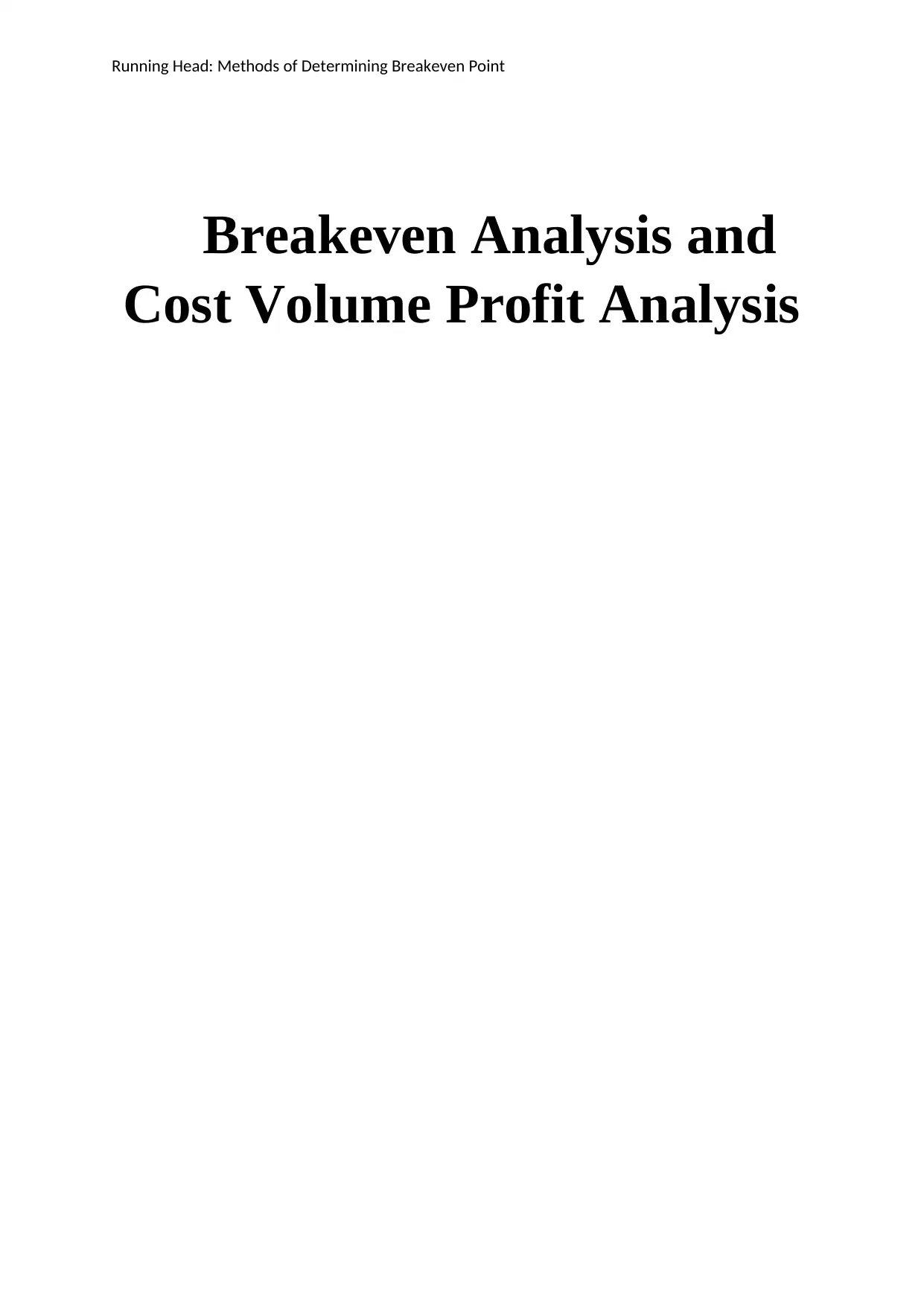
Running Head: Methods of Determining Breakeven Point
Breakeven Analysis and
Cost Volume Profit Analysis
Breakeven Analysis and
Cost Volume Profit Analysis
Secure Best Marks with AI Grader
Need help grading? Try our AI Grader for instant feedback on your assignments.
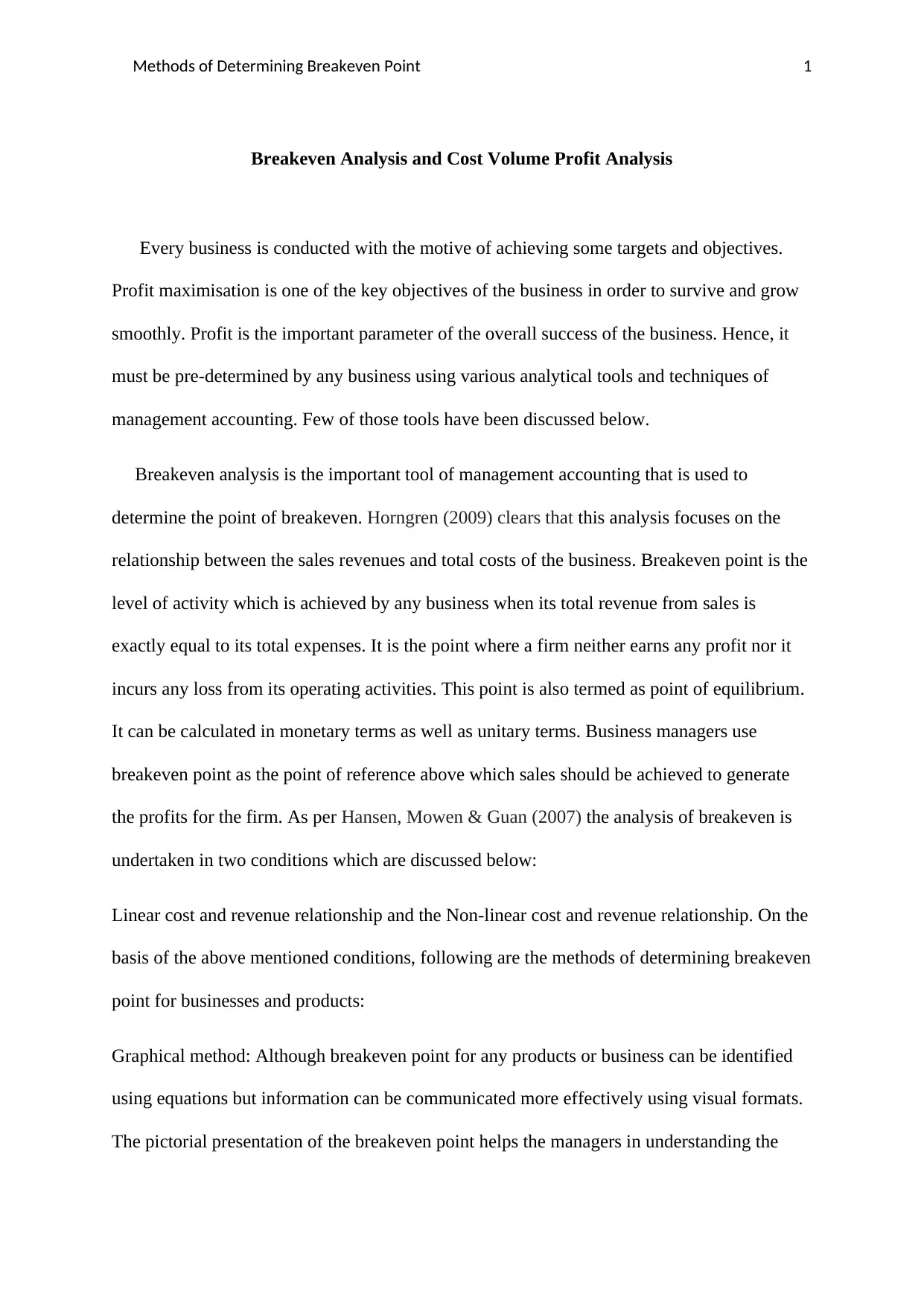
Methods of Determining Breakeven Point 1
Breakeven Analysis and Cost Volume Profit Analysis
Every business is conducted with the motive of achieving some targets and objectives.
Profit maximisation is one of the key objectives of the business in order to survive and grow
smoothly. Profit is the important parameter of the overall success of the business. Hence, it
must be pre-determined by any business using various analytical tools and techniques of
management accounting. Few of those tools have been discussed below.
Breakeven analysis is the important tool of management accounting that is used to
determine the point of breakeven. Horngren (2009) clears that this analysis focuses on the
relationship between the sales revenues and total costs of the business. Breakeven point is the
level of activity which is achieved by any business when its total revenue from sales is
exactly equal to its total expenses. It is the point where a firm neither earns any profit nor it
incurs any loss from its operating activities. This point is also termed as point of equilibrium.
It can be calculated in monetary terms as well as unitary terms. Business managers use
breakeven point as the point of reference above which sales should be achieved to generate
the profits for the firm. As per Hansen, Mowen & Guan (2007) the analysis of breakeven is
undertaken in two conditions which are discussed below:
Linear cost and revenue relationship and the Non-linear cost and revenue relationship. On the
basis of the above mentioned conditions, following are the methods of determining breakeven
point for businesses and products:
Graphical method: Although breakeven point for any products or business can be identified
using equations but information can be communicated more effectively using visual formats.
The pictorial presentation of the breakeven point helps the managers in understanding the
Breakeven Analysis and Cost Volume Profit Analysis
Every business is conducted with the motive of achieving some targets and objectives.
Profit maximisation is one of the key objectives of the business in order to survive and grow
smoothly. Profit is the important parameter of the overall success of the business. Hence, it
must be pre-determined by any business using various analytical tools and techniques of
management accounting. Few of those tools have been discussed below.
Breakeven analysis is the important tool of management accounting that is used to
determine the point of breakeven. Horngren (2009) clears that this analysis focuses on the
relationship between the sales revenues and total costs of the business. Breakeven point is the
level of activity which is achieved by any business when its total revenue from sales is
exactly equal to its total expenses. It is the point where a firm neither earns any profit nor it
incurs any loss from its operating activities. This point is also termed as point of equilibrium.
It can be calculated in monetary terms as well as unitary terms. Business managers use
breakeven point as the point of reference above which sales should be achieved to generate
the profits for the firm. As per Hansen, Mowen & Guan (2007) the analysis of breakeven is
undertaken in two conditions which are discussed below:
Linear cost and revenue relationship and the Non-linear cost and revenue relationship. On the
basis of the above mentioned conditions, following are the methods of determining breakeven
point for businesses and products:
Graphical method: Although breakeven point for any products or business can be identified
using equations but information can be communicated more effectively using visual formats.
The pictorial presentation of the breakeven point helps the managers in understanding the
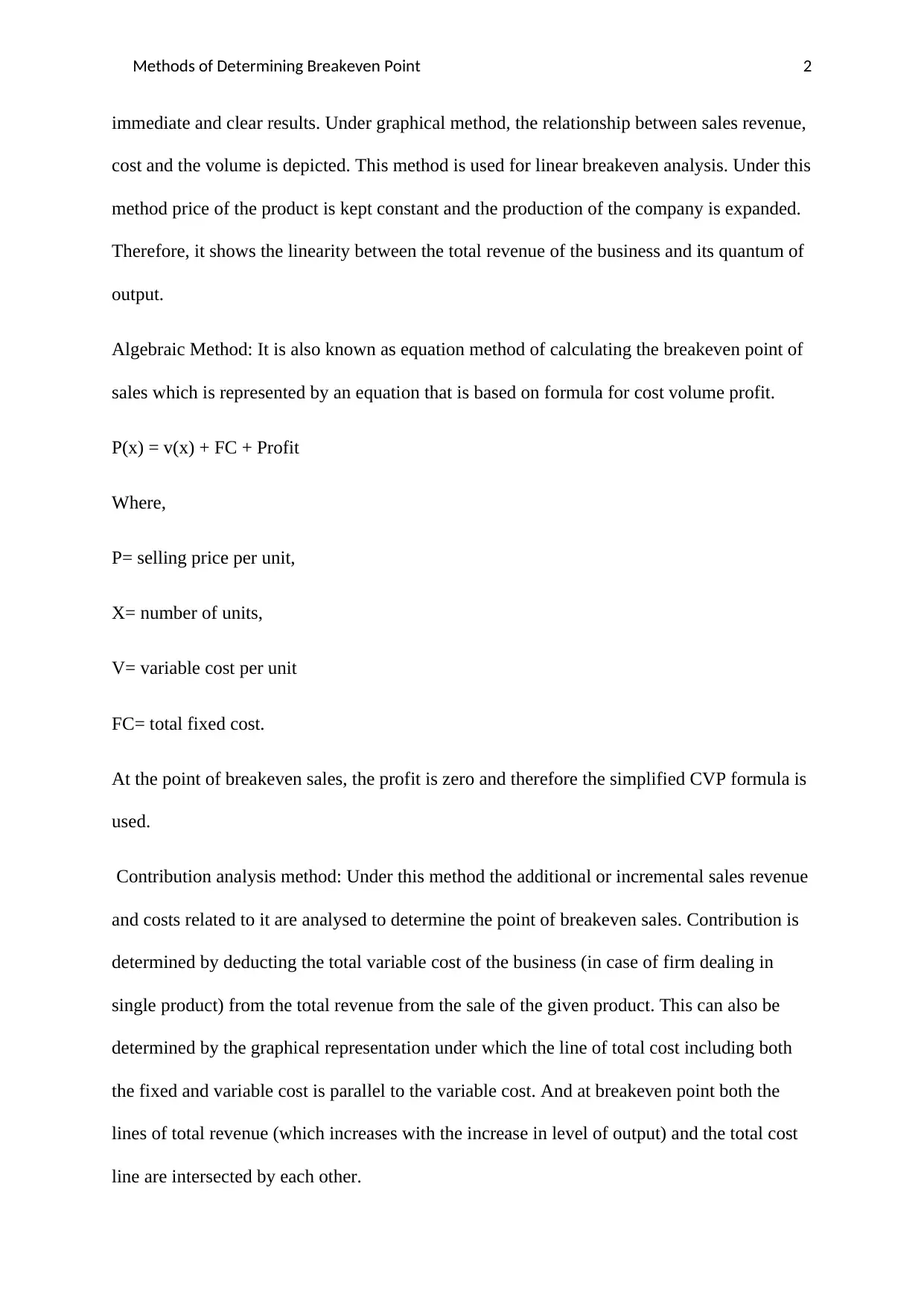
Methods of Determining Breakeven Point 2
immediate and clear results. Under graphical method, the relationship between sales revenue,
cost and the volume is depicted. This method is used for linear breakeven analysis. Under this
method price of the product is kept constant and the production of the company is expanded.
Therefore, it shows the linearity between the total revenue of the business and its quantum of
output.
Algebraic Method: It is also known as equation method of calculating the breakeven point of
sales which is represented by an equation that is based on formula for cost volume profit.
P(x) = v(x) + FC + Profit
Where,
P= selling price per unit,
X= number of units,
V= variable cost per unit
FC= total fixed cost.
At the point of breakeven sales, the profit is zero and therefore the simplified CVP formula is
used.
Contribution analysis method: Under this method the additional or incremental sales revenue
and costs related to it are analysed to determine the point of breakeven sales. Contribution is
determined by deducting the total variable cost of the business (in case of firm dealing in
single product) from the total revenue from the sale of the given product. This can also be
determined by the graphical representation under which the line of total cost including both
the fixed and variable cost is parallel to the variable cost. And at breakeven point both the
lines of total revenue (which increases with the increase in level of output) and the total cost
line are intersected by each other.
immediate and clear results. Under graphical method, the relationship between sales revenue,
cost and the volume is depicted. This method is used for linear breakeven analysis. Under this
method price of the product is kept constant and the production of the company is expanded.
Therefore, it shows the linearity between the total revenue of the business and its quantum of
output.
Algebraic Method: It is also known as equation method of calculating the breakeven point of
sales which is represented by an equation that is based on formula for cost volume profit.
P(x) = v(x) + FC + Profit
Where,
P= selling price per unit,
X= number of units,
V= variable cost per unit
FC= total fixed cost.
At the point of breakeven sales, the profit is zero and therefore the simplified CVP formula is
used.
Contribution analysis method: Under this method the additional or incremental sales revenue
and costs related to it are analysed to determine the point of breakeven sales. Contribution is
determined by deducting the total variable cost of the business (in case of firm dealing in
single product) from the total revenue from the sale of the given product. This can also be
determined by the graphical representation under which the line of total cost including both
the fixed and variable cost is parallel to the variable cost. And at breakeven point both the
lines of total revenue (which increases with the increase in level of output) and the total cost
line are intersected by each other.
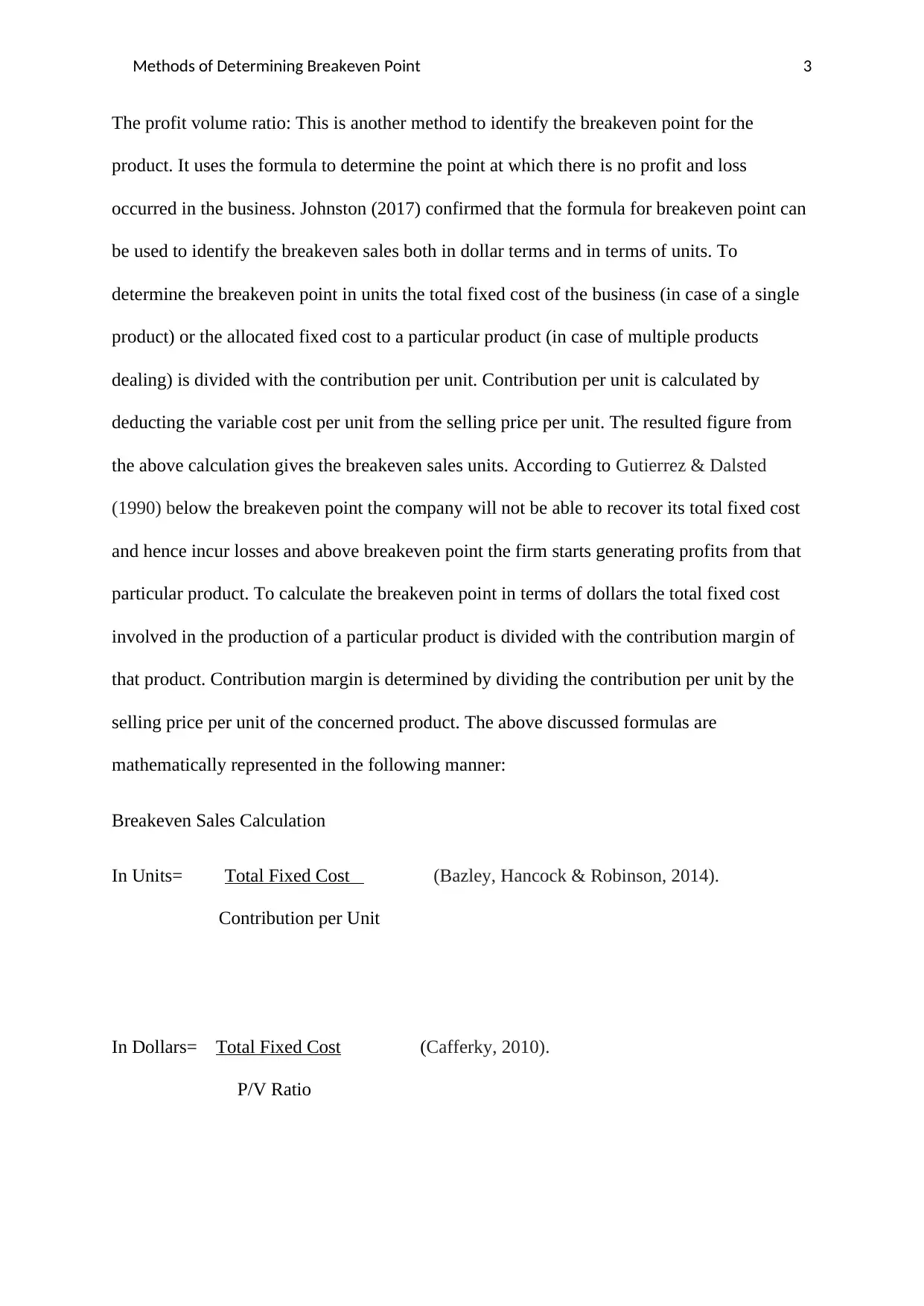
Methods of Determining Breakeven Point 3
The profit volume ratio: This is another method to identify the breakeven point for the
product. It uses the formula to determine the point at which there is no profit and loss
occurred in the business. Johnston (2017) confirmed that the formula for breakeven point can
be used to identify the breakeven sales both in dollar terms and in terms of units. To
determine the breakeven point in units the total fixed cost of the business (in case of a single
product) or the allocated fixed cost to a particular product (in case of multiple products
dealing) is divided with the contribution per unit. Contribution per unit is calculated by
deducting the variable cost per unit from the selling price per unit. The resulted figure from
the above calculation gives the breakeven sales units. According to Gutierrez & Dalsted
(1990) below the breakeven point the company will not be able to recover its total fixed cost
and hence incur losses and above breakeven point the firm starts generating profits from that
particular product. To calculate the breakeven point in terms of dollars the total fixed cost
involved in the production of a particular product is divided with the contribution margin of
that product. Contribution margin is determined by dividing the contribution per unit by the
selling price per unit of the concerned product. The above discussed formulas are
mathematically represented in the following manner:
Breakeven Sales Calculation
In Units= Total Fixed Cost (Bazley, Hancock & Robinson, 2014).
Contribution per Unit
In Dollars= Total Fixed Cost (Cafferky, 2010).
P/V Ratio
The profit volume ratio: This is another method to identify the breakeven point for the
product. It uses the formula to determine the point at which there is no profit and loss
occurred in the business. Johnston (2017) confirmed that the formula for breakeven point can
be used to identify the breakeven sales both in dollar terms and in terms of units. To
determine the breakeven point in units the total fixed cost of the business (in case of a single
product) or the allocated fixed cost to a particular product (in case of multiple products
dealing) is divided with the contribution per unit. Contribution per unit is calculated by
deducting the variable cost per unit from the selling price per unit. The resulted figure from
the above calculation gives the breakeven sales units. According to Gutierrez & Dalsted
(1990) below the breakeven point the company will not be able to recover its total fixed cost
and hence incur losses and above breakeven point the firm starts generating profits from that
particular product. To calculate the breakeven point in terms of dollars the total fixed cost
involved in the production of a particular product is divided with the contribution margin of
that product. Contribution margin is determined by dividing the contribution per unit by the
selling price per unit of the concerned product. The above discussed formulas are
mathematically represented in the following manner:
Breakeven Sales Calculation
In Units= Total Fixed Cost (Bazley, Hancock & Robinson, 2014).
Contribution per Unit
In Dollars= Total Fixed Cost (Cafferky, 2010).
P/V Ratio
Secure Best Marks with AI Grader
Need help grading? Try our AI Grader for instant feedback on your assignments.
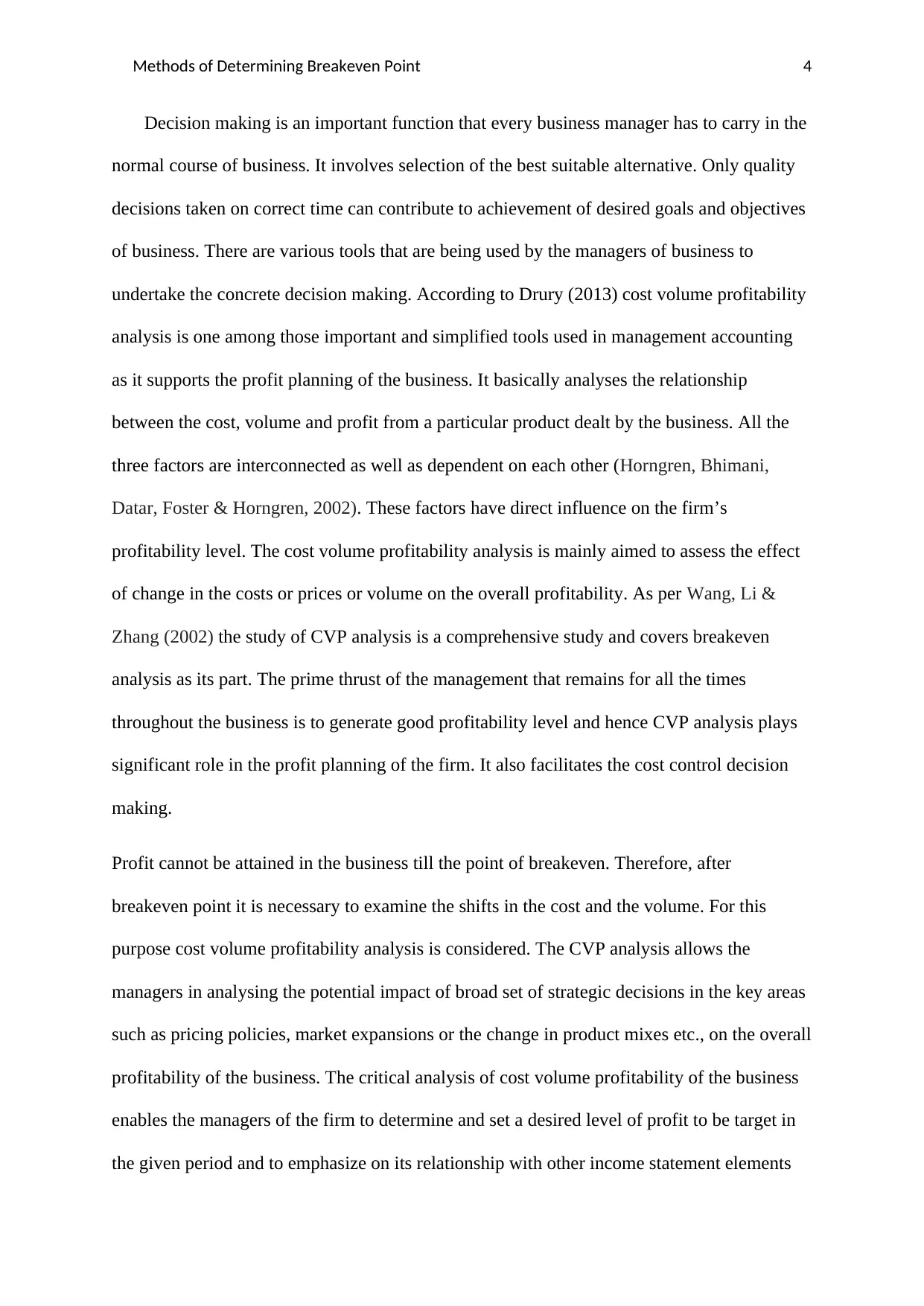
Methods of Determining Breakeven Point 4
Decision making is an important function that every business manager has to carry in the
normal course of business. It involves selection of the best suitable alternative. Only quality
decisions taken on correct time can contribute to achievement of desired goals and objectives
of business. There are various tools that are being used by the managers of business to
undertake the concrete decision making. According to Drury (2013) cost volume profitability
analysis is one among those important and simplified tools used in management accounting
as it supports the profit planning of the business. It basically analyses the relationship
between the cost, volume and profit from a particular product dealt by the business. All the
three factors are interconnected as well as dependent on each other (Horngren, Bhimani,
Datar, Foster & Horngren, 2002). These factors have direct influence on the firm’s
profitability level. The cost volume profitability analysis is mainly aimed to assess the effect
of change in the costs or prices or volume on the overall profitability. As per Wang, Li &
Zhang (2002) the study of CVP analysis is a comprehensive study and covers breakeven
analysis as its part. The prime thrust of the management that remains for all the times
throughout the business is to generate good profitability level and hence CVP analysis plays
significant role in the profit planning of the firm. It also facilitates the cost control decision
making.
Profit cannot be attained in the business till the point of breakeven. Therefore, after
breakeven point it is necessary to examine the shifts in the cost and the volume. For this
purpose cost volume profitability analysis is considered. The CVP analysis allows the
managers in analysing the potential impact of broad set of strategic decisions in the key areas
such as pricing policies, market expansions or the change in product mixes etc., on the overall
profitability of the business. The critical analysis of cost volume profitability of the business
enables the managers of the firm to determine and set a desired level of profit to be target in
the given period and to emphasize on its relationship with other income statement elements
Decision making is an important function that every business manager has to carry in the
normal course of business. It involves selection of the best suitable alternative. Only quality
decisions taken on correct time can contribute to achievement of desired goals and objectives
of business. There are various tools that are being used by the managers of business to
undertake the concrete decision making. According to Drury (2013) cost volume profitability
analysis is one among those important and simplified tools used in management accounting
as it supports the profit planning of the business. It basically analyses the relationship
between the cost, volume and profit from a particular product dealt by the business. All the
three factors are interconnected as well as dependent on each other (Horngren, Bhimani,
Datar, Foster & Horngren, 2002). These factors have direct influence on the firm’s
profitability level. The cost volume profitability analysis is mainly aimed to assess the effect
of change in the costs or prices or volume on the overall profitability. As per Wang, Li &
Zhang (2002) the study of CVP analysis is a comprehensive study and covers breakeven
analysis as its part. The prime thrust of the management that remains for all the times
throughout the business is to generate good profitability level and hence CVP analysis plays
significant role in the profit planning of the firm. It also facilitates the cost control decision
making.
Profit cannot be attained in the business till the point of breakeven. Therefore, after
breakeven point it is necessary to examine the shifts in the cost and the volume. For this
purpose cost volume profitability analysis is considered. The CVP analysis allows the
managers in analysing the potential impact of broad set of strategic decisions in the key areas
such as pricing policies, market expansions or the change in product mixes etc., on the overall
profitability of the business. The critical analysis of cost volume profitability of the business
enables the managers of the firm to determine and set a desired level of profit to be target in
the given period and to emphasize on its relationship with other income statement elements
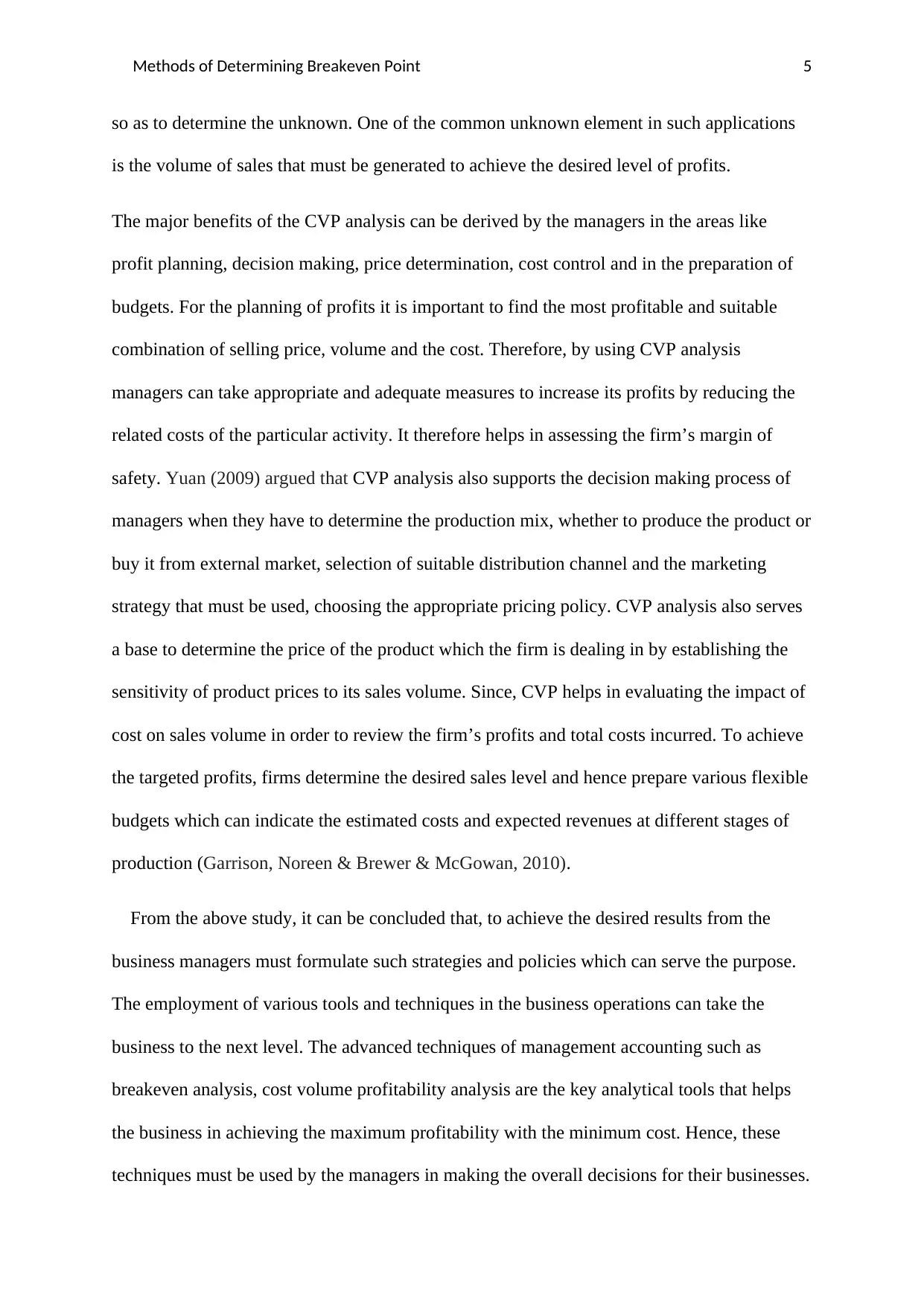
Methods of Determining Breakeven Point 5
so as to determine the unknown. One of the common unknown element in such applications
is the volume of sales that must be generated to achieve the desired level of profits.
The major benefits of the CVP analysis can be derived by the managers in the areas like
profit planning, decision making, price determination, cost control and in the preparation of
budgets. For the planning of profits it is important to find the most profitable and suitable
combination of selling price, volume and the cost. Therefore, by using CVP analysis
managers can take appropriate and adequate measures to increase its profits by reducing the
related costs of the particular activity. It therefore helps in assessing the firm’s margin of
safety. Yuan (2009) argued that CVP analysis also supports the decision making process of
managers when they have to determine the production mix, whether to produce the product or
buy it from external market, selection of suitable distribution channel and the marketing
strategy that must be used, choosing the appropriate pricing policy. CVP analysis also serves
a base to determine the price of the product which the firm is dealing in by establishing the
sensitivity of product prices to its sales volume. Since, CVP helps in evaluating the impact of
cost on sales volume in order to review the firm’s profits and total costs incurred. To achieve
the targeted profits, firms determine the desired sales level and hence prepare various flexible
budgets which can indicate the estimated costs and expected revenues at different stages of
production (Garrison, Noreen & Brewer & McGowan, 2010).
From the above study, it can be concluded that, to achieve the desired results from the
business managers must formulate such strategies and policies which can serve the purpose.
The employment of various tools and techniques in the business operations can take the
business to the next level. The advanced techniques of management accounting such as
breakeven analysis, cost volume profitability analysis are the key analytical tools that helps
the business in achieving the maximum profitability with the minimum cost. Hence, these
techniques must be used by the managers in making the overall decisions for their businesses.
so as to determine the unknown. One of the common unknown element in such applications
is the volume of sales that must be generated to achieve the desired level of profits.
The major benefits of the CVP analysis can be derived by the managers in the areas like
profit planning, decision making, price determination, cost control and in the preparation of
budgets. For the planning of profits it is important to find the most profitable and suitable
combination of selling price, volume and the cost. Therefore, by using CVP analysis
managers can take appropriate and adequate measures to increase its profits by reducing the
related costs of the particular activity. It therefore helps in assessing the firm’s margin of
safety. Yuan (2009) argued that CVP analysis also supports the decision making process of
managers when they have to determine the production mix, whether to produce the product or
buy it from external market, selection of suitable distribution channel and the marketing
strategy that must be used, choosing the appropriate pricing policy. CVP analysis also serves
a base to determine the price of the product which the firm is dealing in by establishing the
sensitivity of product prices to its sales volume. Since, CVP helps in evaluating the impact of
cost on sales volume in order to review the firm’s profits and total costs incurred. To achieve
the targeted profits, firms determine the desired sales level and hence prepare various flexible
budgets which can indicate the estimated costs and expected revenues at different stages of
production (Garrison, Noreen & Brewer & McGowan, 2010).
From the above study, it can be concluded that, to achieve the desired results from the
business managers must formulate such strategies and policies which can serve the purpose.
The employment of various tools and techniques in the business operations can take the
business to the next level. The advanced techniques of management accounting such as
breakeven analysis, cost volume profitability analysis are the key analytical tools that helps
the business in achieving the maximum profitability with the minimum cost. Hence, these
techniques must be used by the managers in making the overall decisions for their businesses.

Methods of Determining Breakeven Point 6
Paraphrase This Document
Need a fresh take? Get an instant paraphrase of this document with our AI Paraphraser
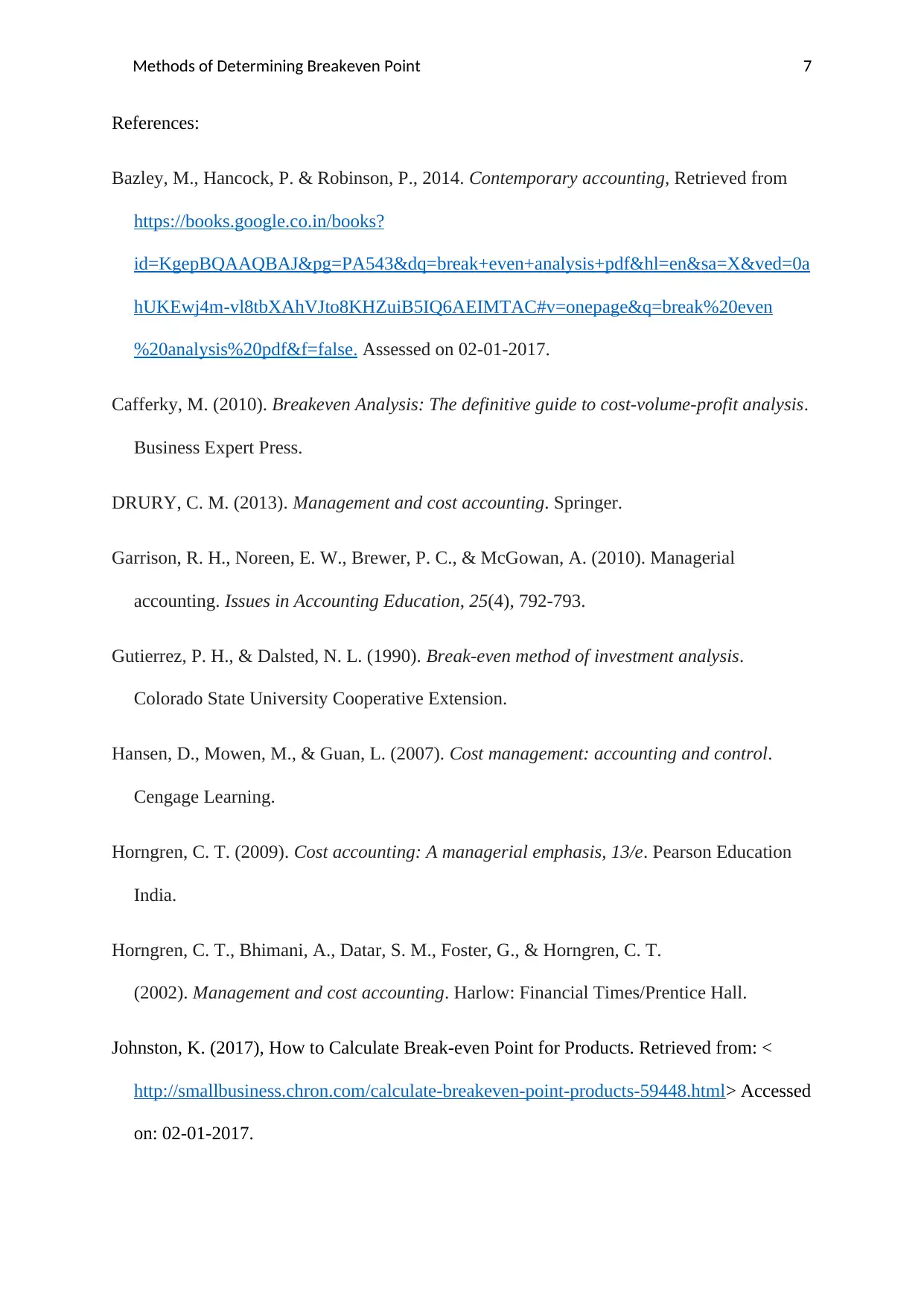
Methods of Determining Breakeven Point 7
References:
Bazley, M., Hancock, P. & Robinson, P., 2014. Contemporary accounting, Retrieved from
https://books.google.co.in/books?
id=KgepBQAAQBAJ&pg=PA543&dq=break+even+analysis+pdf&hl=en&sa=X&ved=0a
hUKEwj4m-vl8tbXAhVJto8KHZuiB5IQ6AEIMTAC#v=onepage&q=break%20even
%20analysis%20pdf&f=false. Assessed on 02-01-2017.
Cafferky, M. (2010). Breakeven Analysis: The definitive guide to cost-volume-profit analysis.
Business Expert Press.
DRURY, C. M. (2013). Management and cost accounting. Springer.
Garrison, R. H., Noreen, E. W., Brewer, P. C., & McGowan, A. (2010). Managerial
accounting. Issues in Accounting Education, 25(4), 792-793.
Gutierrez, P. H., & Dalsted, N. L. (1990). Break-even method of investment analysis.
Colorado State University Cooperative Extension.
Hansen, D., Mowen, M., & Guan, L. (2007). Cost management: accounting and control.
Cengage Learning.
Horngren, C. T. (2009). Cost accounting: A managerial emphasis, 13/e. Pearson Education
India.
Horngren, C. T., Bhimani, A., Datar, S. M., Foster, G., & Horngren, C. T.
(2002). Management and cost accounting. Harlow: Financial Times/Prentice Hall.
Johnston, K. (2017), How to Calculate Break-even Point for Products. Retrieved from: <
http://smallbusiness.chron.com/calculate-breakeven-point-products-59448.html> Accessed
on: 02-01-2017.
References:
Bazley, M., Hancock, P. & Robinson, P., 2014. Contemporary accounting, Retrieved from
https://books.google.co.in/books?
id=KgepBQAAQBAJ&pg=PA543&dq=break+even+analysis+pdf&hl=en&sa=X&ved=0a
hUKEwj4m-vl8tbXAhVJto8KHZuiB5IQ6AEIMTAC#v=onepage&q=break%20even
%20analysis%20pdf&f=false. Assessed on 02-01-2017.
Cafferky, M. (2010). Breakeven Analysis: The definitive guide to cost-volume-profit analysis.
Business Expert Press.
DRURY, C. M. (2013). Management and cost accounting. Springer.
Garrison, R. H., Noreen, E. W., Brewer, P. C., & McGowan, A. (2010). Managerial
accounting. Issues in Accounting Education, 25(4), 792-793.
Gutierrez, P. H., & Dalsted, N. L. (1990). Break-even method of investment analysis.
Colorado State University Cooperative Extension.
Hansen, D., Mowen, M., & Guan, L. (2007). Cost management: accounting and control.
Cengage Learning.
Horngren, C. T. (2009). Cost accounting: A managerial emphasis, 13/e. Pearson Education
India.
Horngren, C. T., Bhimani, A., Datar, S. M., Foster, G., & Horngren, C. T.
(2002). Management and cost accounting. Harlow: Financial Times/Prentice Hall.
Johnston, K. (2017), How to Calculate Break-even Point for Products. Retrieved from: <
http://smallbusiness.chron.com/calculate-breakeven-point-products-59448.html> Accessed
on: 02-01-2017.
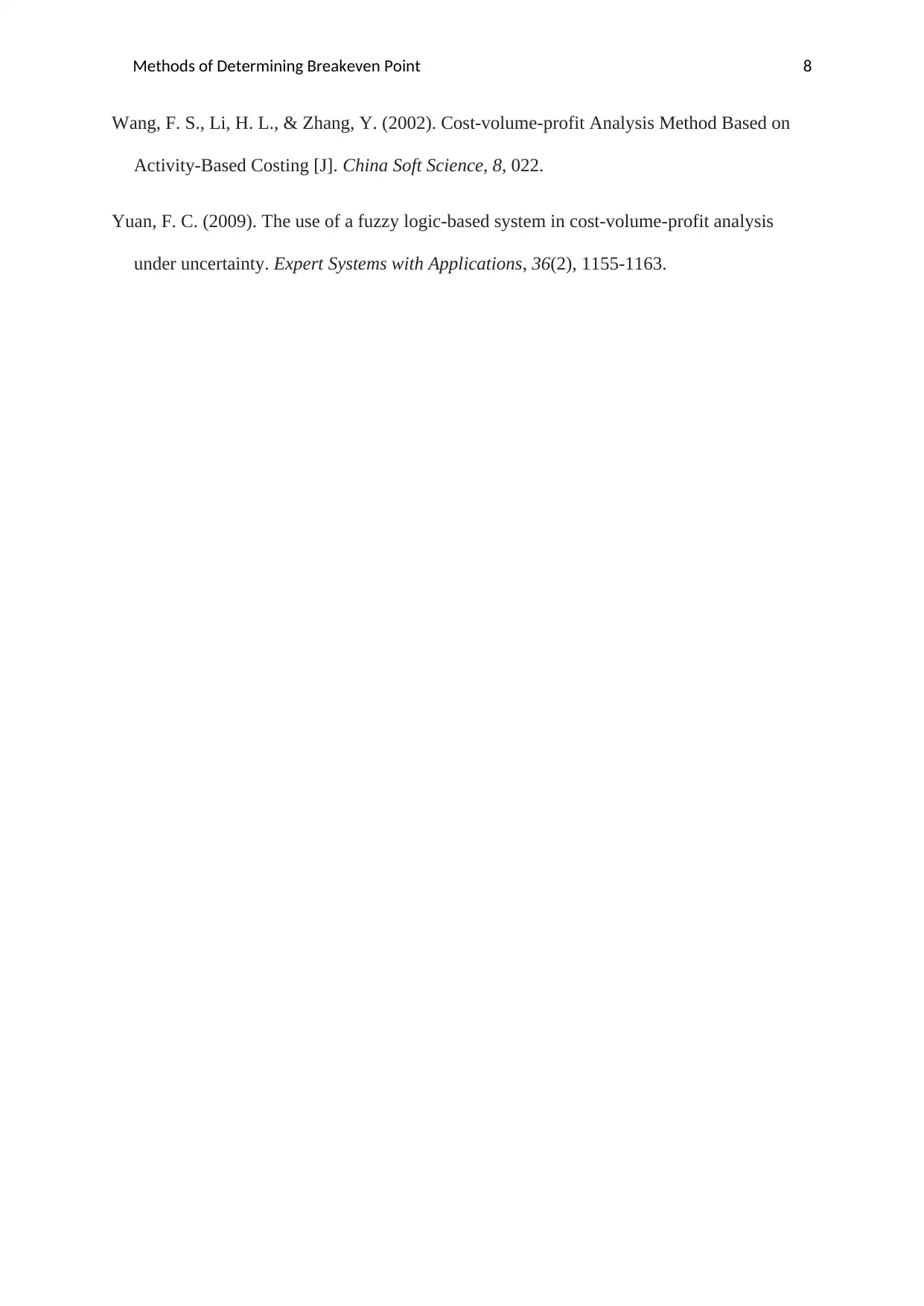
Methods of Determining Breakeven Point 8
Wang, F. S., Li, H. L., & Zhang, Y. (2002). Cost-volume-profit Analysis Method Based on
Activity-Based Costing [J]. China Soft Science, 8, 022.
Yuan, F. C. (2009). The use of a fuzzy logic-based system in cost-volume-profit analysis
under uncertainty. Expert Systems with Applications, 36(2), 1155-1163.
Wang, F. S., Li, H. L., & Zhang, Y. (2002). Cost-volume-profit Analysis Method Based on
Activity-Based Costing [J]. China Soft Science, 8, 022.
Yuan, F. C. (2009). The use of a fuzzy logic-based system in cost-volume-profit analysis
under uncertainty. Expert Systems with Applications, 36(2), 1155-1163.
1 out of 9
Related Documents
Your All-in-One AI-Powered Toolkit for Academic Success.
+13062052269
info@desklib.com
Available 24*7 on WhatsApp / Email
![[object Object]](/_next/static/media/star-bottom.7253800d.svg)
Unlock your academic potential
© 2024 | Zucol Services PVT LTD | All rights reserved.





